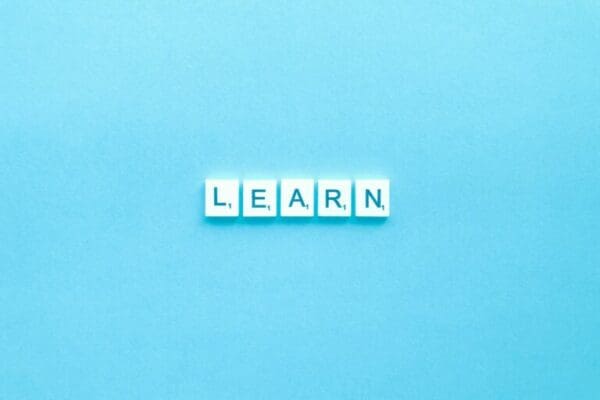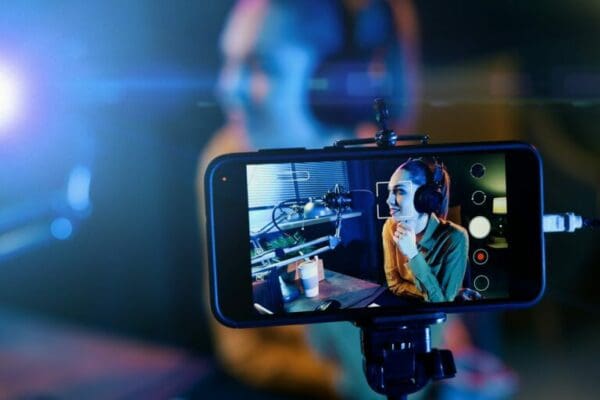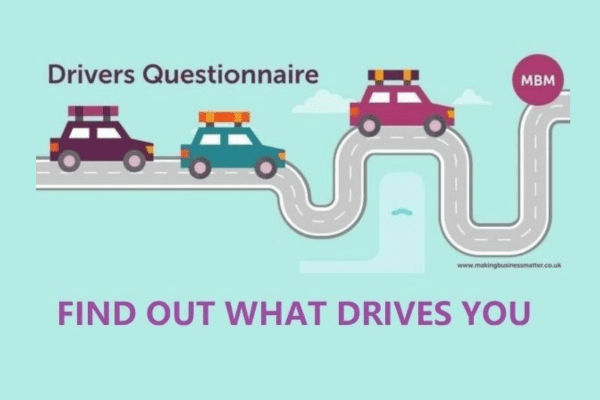Try Structured Approaches to Acquiring and Applying Knowledge
What does it mean to learn? For some, it’s about discovering new things in life that teach them something new. Others see learning as remembering information. And some think it’s about applying what they know. But the real definition doesn’t matter as much as the process behind it. Research shows that learning is more than we think. And recent studies can help make learning better and more enjoyable. Learning models are part of this research, and anyone can use them to improve their learning.
What Are Learning Models?
A learning model is a way to learn new skills or information. These models have sub-categories that break down into different learning styles. Below, we will explore seven of the most popular learning models.
#1. Kolb’s Learning Cycle
Click the image below for a higher resolution.
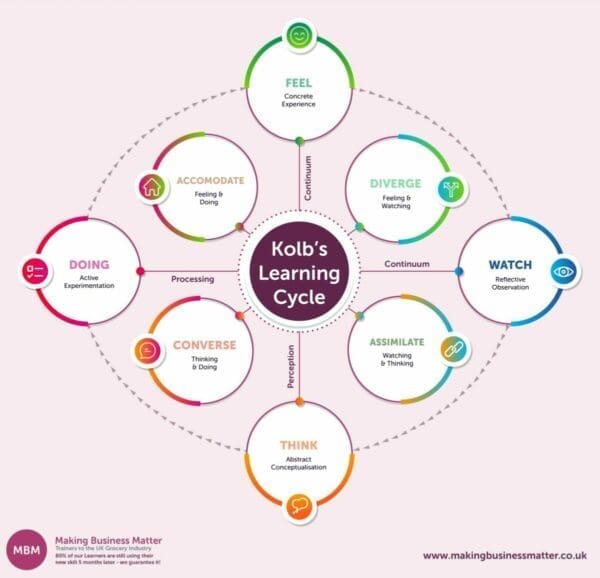
David A. Kolb’s learning model is also known as the ‘experiential learning theory’. The basis of Kolb’s model is that learning takes place within a 4 stage process.
- Concrete learning.
- Reflective observation.
- Abstract conceptualisation.
- Active experimentation.
1- Concrete Learning
During the first stage, the learner will undertake one of two processes. They will either, experience something completely new, or experience a variation of an old experience.
2- Reflective Observation
During this stage, the learner reflects on the outcome of stage one. Their understanding, and takeaway, from this reflection is based solely on the learner’s own interpretation.
3- Abstract Conceptualisation
Here, the learner has experienced something during stage one and reflected on it in stage two. Then, the learner utilises this information and either forms new ideas, or modifies old ones.
4- Active Experimentation
Now, the learner has either brand new ideas or newly modified ideas to put into practice. Stage four is the point at which all information and products are used to develop new abilities.
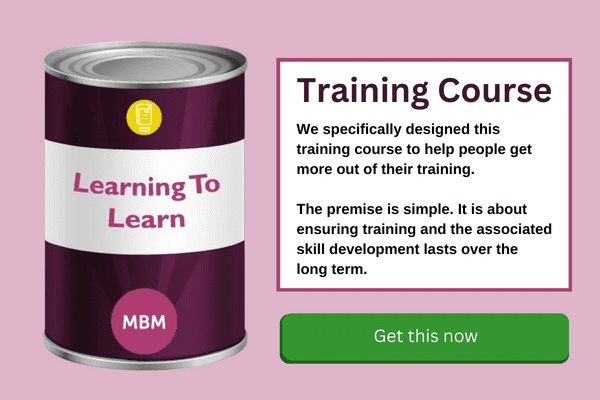
Different Learners
This cycle of 4 stages naturally breeds 4 different types of learners:
1- Convergers
A converger will favour the last two stages of the cycle. This is where practicality and experimentation overtake the learning process. The converger prefers a hands-on task in which they can form new ideas through the process of experimentation. So, a converger must apply the knowledge practically in order to increase understanding.
2- Divergers
A diverger relies on the first two stages of the cycle, where they can learn, reflect and imagine. The diverger favours simple imagination to compile and understand new and unique ideas. So, more time will be spent reflecting on new experiences, by the diverger, than applying knowledge to practice.
3- Assimilators
An assimilator would rather research and plan than apply and practice. The assimilator prefers the second and third stages of the cycle. This is where new or variant experiences have taken place and the learner is reflecting and understanding these new ideas. The third cycle stage is where information is utilised to develop new ideas or change and shape old ones to become of use in new situations.
4- Accommodators
An accommodator prefers stages one and four of the cycle. This is the direct application of learning to real-world situations. In stage one, the accommodator experiences something, and in stage 4, this experience is put directly into practice for experimentation. The accommodator would favour going from stage one to four many times, then through the entire cycle fewer times.
The Kolb learning model shows us that there are 4 learners, each with different paths through the cycle presented by Kolb himself. However, Neil Fleming and Coleen Mills of the ‘VARK’ model would suggest there are 4 different learners.
#2. ‘VARK’ Learning Model
Click the image below for a higher resolution.
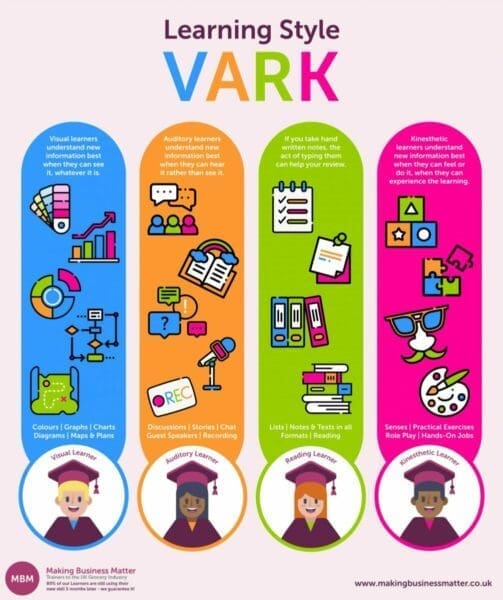
Fleming and Mills, in 1992, observed many hours of student learning environments. Their conclusion was also that learning is defined by four different types of learners. The VARK model gives us visual, auditory, read/write, and kinesthetic learners. Each learns in unique ways:
1- The Visual Learner
Someone who learns by vision will have greater understanding and memory retention of things they see. For example, a visual learner would gain more from reading a hard copy of a book, than listening to an audio version. Also, images and graphs will make a big impact on these learners. Therefore, focus on visual aids that make the topic more inviting for the learner.
2- The Auditory Learner
Someone who learns by audible stimulus will have a greater understanding and memory retention of things they hear. This works opposite to the visual learner, as auditory learners would gain more from an audiobook than a paperback.
3- The Read/Write Learner
This learner would remember notes from a book much better after reading it several times over or re-writing the notes out. A read/write learner could study for a test simply by repeatedly reading and re-writing notes from a textbook. Therefore, the more times the learner reads and re-writes, the greater the memory retention and understanding.
4- The Kinesthetic Learner
Someone who learns kinesthetically must do, practice, and experience. This learner would like to be given the opportunity to actively try to learn something in order to gain a base understanding. Rather than listening to any extensive explanation before trying something. For example, a practical science experiment would give a kinesthetic learner the utmost opportunity to gain knowledge.
VARK is a little more sectioned and rigid than Kolb’s learning model. VARK presents 4 quadrants that the vast majority of people can categorise themselves, and probably their friends, into. Whilst VARK is more rigid, Kolb’s model gives a more fluid approach. So perhaps potentially more difficult to categorise yourself, there is the consideration of adaption.
Fleming and Collins add to their 4 types of learners by presenting two further types. Learners type 1 and 2 can both fit anywhere into the 4 established types of learners. Type 2 learners, however, do not adapt. If a type 2, visual learner, is given an epistemically kinesthetic task, they’d either struggle to complete it, or be forced to adapt the task to the visual learning style.
However, type 1 learners can shift and change from one style to another based on the task at hand. The type 1 learner will adapt to the task, rather than force the task to adapt to themselves. A type 1 learner is a faster and more applicable learner.
#3. Herrmann Brain Dominance Instrument (HBDI)
HBDI, or the Herrmann Brain Dominance Instrument, presents another 4 types of learners. Whilst HBDI is a learning model, William Herrmann developed many ideas about the thinking preferences of people. Whilst learning styles are the focus here, we have a fantastic HBDI Ultimate Guide explaining the quadrants of the brain, and all things HBDI.
Click the image below for a higher resolution.
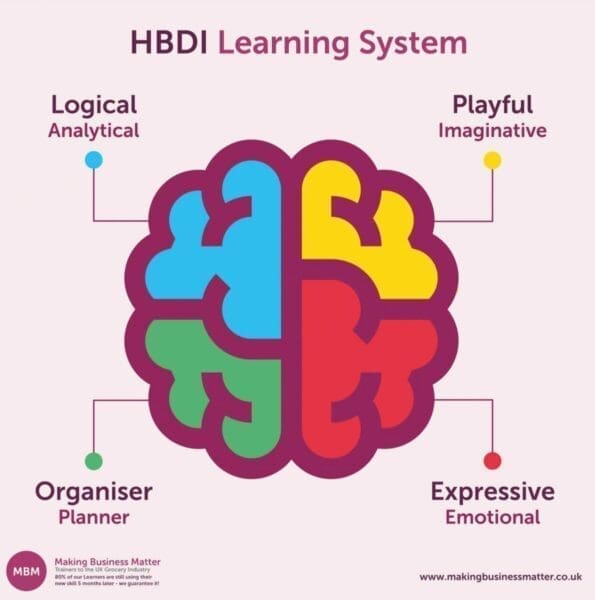
Herrmann breaks down learning into a further 4 learners.
1- The Theorist
Theorists naturally learn in sequence. Solving one problem, then the next, learning by the methodical process. These learners are good at memorising and recalling information. Theorists lend themselves to left-brain learning like maths and science.
2- The Organiser
Organisers do what they say on the tin. For this learner, information must be organised and arranged before it can be absorbed. Therefore, the organiser lends itself to systematic tasks, and memorising events in a timeline.
3- The Humanitarian
A humanitarian’s main focus is people and interpersonal thinking. This person’s learning stems from emotion, conversation, and expression. A humanitarian is usually a good team player or team leader, for example, a film director.
4- The Innovator
Innovators build. Previous knowledge and understanding are built upon to form new ideas. The innovator is an independently creative problem solver. A CEO, for example.
Thus far, these learning models have each split learners into 4 categories. Whilst this is the basis of Kolb’s model and VARK, HDBI takes this forth into a more detailed understanding of our mental preferences that categorise our thinking patterns further.
Herrmann’s identification of four brain quadrants permeates throughout the vast majority of learning models. This shows that the front, back, left and right of the brain all operate in different ways. And for different purposes which are agreed upon among learning experts globally. Richard Felder and Linda Silverman, however, may slightly disagree.
#4. ‘Felder-Silverman’ Learning Style
Click the image below for a higher resolution.
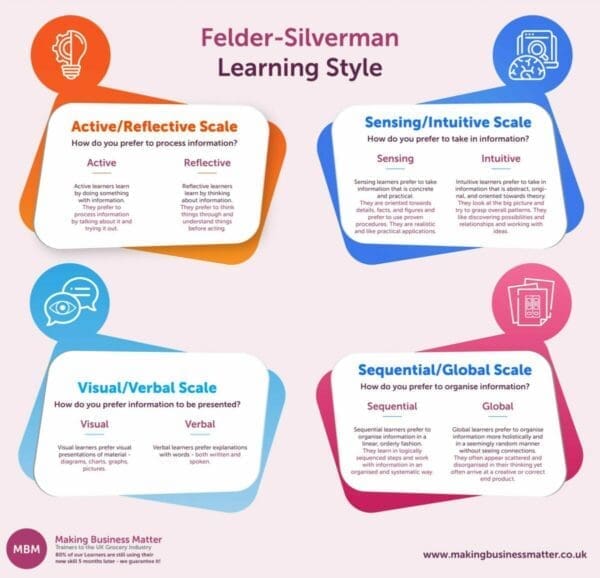
The Felder-Silverman model suggests that there are not only many different types of learners but many different combinations of learning styles. Taking from the type 1 and type 2 learners from ‘VARK’, Felder-Silverman does suggest that some learners adapt, and some do not.
The ones who adapt (which would be referred to as a type 1 learner) are said by Felder-Silverman to be able to shift from process to process, style to style, and combinations therein. There is still mention of the ‘type 2 learner’, who will not shift and adapt, but Felder-Silverman suggests that there can still be combinations of learning styles suited to the individual.
If you struggled to categorise yourself into the quadrants of Kolb’s model, HBDI or VARK, then Felder-Silverman will most likely provide a broader way to identify the type of learner you are.
There are still four dimensions. However, each of these sections outlines personality traits that contribute to learning preferences.
The 8 Traits of Felder-Silverman
- Sensing: The preference for concrete thinking – facts, methods, and systems.
- Intuitive: The preference for theories and meanings – concept and innovation.
- Visual: The preference for visual stimulus – diagrams, pictures, flow charts.
- Verbal: The preference for written and spoken explanations.
- Active: The preference for experimenting and trying things out – group work, sensory learning.
- Reflective: The preference for time to think over, understand and solve – either alone or with familiar people.
- Sequential: The preference for linear thinking – learning in small stages.
- Global: The preference for the bigger picture – learns in large steps.
These 8 traits are organised into combinations that make up the four dimensions. Felder-Silverman’s model sees these dimensions applied in different ways to different people. The basis of the model is that each person subconsciously chooses to grasp information in vastly different ways. Therefore, this model is the idea that these ways can be boiled down to a dimension in which the individual is not too harshly categorised in recognition that everyone learns differently.
#5. Gregorc’s ‘Mind Styles’ Learning Model
Click the image below for a higher resolution.
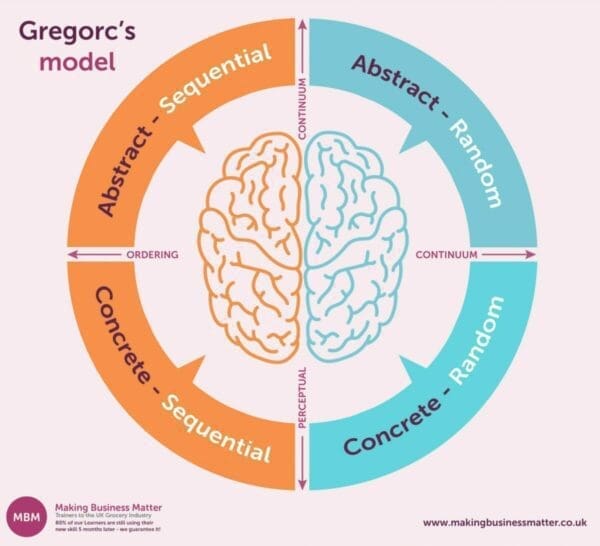
Anthony Gregorc’s conclusion to learning preferences is the ‘Mind Styles’ model. This follows four areas in which learners operate, based on two spectrums. The first spectrum, from left to right, ranges from sequential to random. And, the second spectrum, from down to up, ranges from concrete to abstract.
1- Left and Up
Abstract sequential: This learner can learn through a variety of means and processes. The abstract sequential learner requires organisation and structure in order to process and gain knowledge. However, they are a little freer in learning than most. The abstract sequential learner can adapt and mould to tasks so long as the structure is there.
2- Left and Down
Concrete sequential: This learner requires organisation, structure, and experience in abundance. The concrete sequential learner gains understanding through active experience… structured and organised active experience. These learners prefer step-by-step guides and patterns to follow – they would love a ‘paint by numbers’!
3- Right and Up
Abstract random: This learner is fluid, free, and open with their thinking. This is the key too, reflection. Abstract random learners learn verbally and through interpersonal skills. Much like the humanitarian learner from HBDI. Also, the abstract random learner must take time to reflect, think and build upon previous knowledge in order to solve problems and generate ideas.
4- Right and Down
Concrete random: The concrete random learner is spontaneous, intuitive, and experimental. To learn in a concrete, random fashion seems like an oxymoron, however, this contrast allows for the process of trial and error. The ability to very quickly generate ideas put them into practice and determine a solution is born from this juxtaposition of preferences.
Gregorc’s model recognises that we utilise combinations of preferences to get an outcome. The use of ‘concrete’ and ‘abstract’ to describe preferences is reflected by Kolb’s model where he suggests concrete learning is the preference. Kolb’s model also extends into ‘4MAT’, another model that encapsulates more of his studies.
#6. 4MAT
Click the image below for a higher resolution.
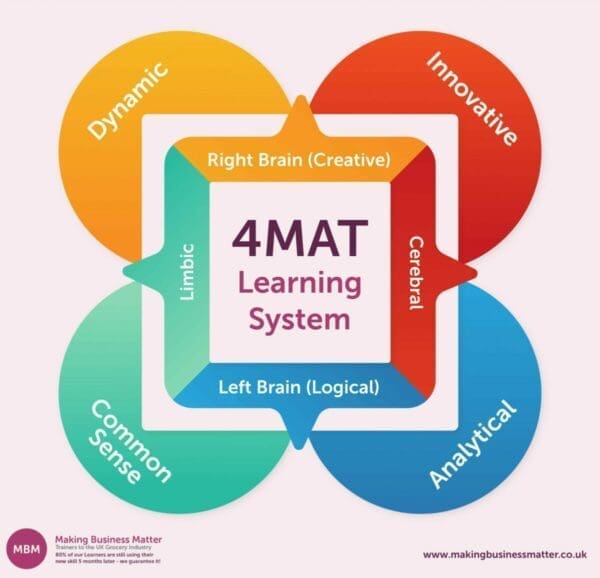
The 4MAT learning model is, as aforementioned, an extension of Kolb’s original model. It does, however, present 4 new learning styles. These are: Innovative Analytical, Dynamic, and Common sense.
1- Innovative
Here, innovative learners theorise their experiences and utilise that information to create the formula for new ideas. The innovative learner favours the right side of the brain – creativity, and expression.
2- Analytical
On the other hand, the analytical learner applies and refines ideas before fully utilising the information. However, the analytical thinker does also theorise experiences. This learner favours the left side of the brain. To analyse and categorise.
3- Common Sense
Next, the common sense thinker will base their learning directly on experiences. This is opposed by the theoisation of the first two styles. The common sense takes real-world situations and applies them to real-world situations.
4- Dynamic
Finally, the dynamic thinker utilises everything from the three styles above but changes the outcome based on personal interpretation. The dynamic thinker is opinion-based and learns across both sides of the brain.
#7. Honey and Mumford Learning Style
Click the image below for a higher resolution.
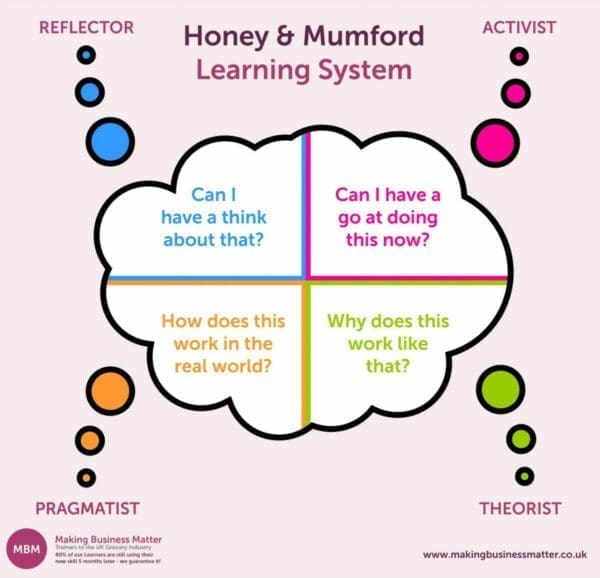
Peter Honey and Alan Mumford developed the Honey-Mumford learning model based on the work of Kolb. They took his 4 presented learning styles and refined them into 4 new styles. The activist, theorist, pragmatist, and reflector styles were the product of this.
1- Activist
The activist thrives on brainstorming, group discussions, and competition. Anything that requires actively doing something to solve problems or generate ideas. For example, a group of activists giving a presentation would include visual aids, interaction, and extensive speaking about the subject.
2- Theorist
While the activist is off ‘doing’, the theorist is analysing the reason why. A theorist collates information through quotes, stories, and statistics and applies them with reasonable logic to conclude with a theory. For example, a group of theorists giving a presentation would include a simple structured explanation of each source of information, why they were collated, and the conclusion that’s drawn from them.
3- Pragmatist
The pragmatist needs time to think about how they might apply theories and actions into their own lives. Pragmatists favour analogies, case studies, and discussions. For example, a group of pragmatists giving a presentation would include real-world examples of how information and ideas can be utilised and applied to people’s lives.
4- Reflector
The reflector thrives on feedback, independence and self-analysis. The reflector is logical and methodical, someone who would prefer to analyse the game from the sidelines, reflect on the analysis, and then go and play it. For example, a group of reflectors giving a presentation would include collated information from questionnaires, observations, and findings to draw a conclusion.
The Honey-Mumford model makes it easy to categorise learners by their preferences for the process.
Summary of Learning Models
- Kolb’s Learning Cycle
- VARK
- HBDI
- Felder-Silverman Learning Style
- Gregorc’s ‘Mind Styles’ Learning Model
- 4MAT
- Honey and Mumford Learning Style
The recognition and identification of learning styles can ignite a much more efficient learning process. If you understand the way in which you prefer to learn, models like the ones above can act as handbooks, therefore, keeping you creative, inspired, focused, or all of the above. These 7 learning models can propel your efficiency and cut your learning curve. Strive to learn quick, strive to make it stick!
Select the Learning Model for You
Now, we have the big question. Which is the BEST model? That question doesn’t have one simple answer. Instead, it depends on your audience. Let me share my experience with you.
Having used a variety of different models over the years, I have found that VARK can be a great combined approach. Imagine, you have a group of staff at different levels of experience and knowledge. Also, you may have them as a group for the first time. Therefore, you may not know the approach that would best suit everyone in the group.
Consider including a mix of all approaches in each section of your learning experience. For example, you are training a new procedure to your team. Start with a run through of the steps by reading them out with the group. This will appeal to your Read/Write and Audio audiences. Next, show visuals of the expected outcome. this could be a pictures or a graph that show the steps and end result. Then, get them to practice the procedure. Therefore, you have the Kinesthetic learners covered. Also, you are able to include a check of the learning by seeing how they can repeat back or perform the task.
Personally, I have found this model to be one of the easiest to apply for a varied learning group. You cover all of the bases as well as the topic at hand. However, you may decide that one of the other models meets your needs better.
Therefore, follow these steps:
#1: Decide the Topic
First, decide on the topic you will cover. Know the full content that needs to be covered. Understand the steps you will follow to deliver the learning experience. Also, consider how you will check if the learning has been successful. Additionally, consider your location, resources, and time when planning any learning experience for your team.
#2: Understand Your Audience
Next, think about the learners. Have they been with you before for a learning experience? And, how did they respond to your delivery? Without this knowledge, you could easily choose the wrong model. As I mentioned, VARK can help overcome that concern. However, once you know your learners better, you can make other choices.
Also, consider the size of the group you will include in the learning experience. For example, hands-on demonstrations may not be a practical approach for a large group. Also, simply reading to a group may not hit the mark for something that also needs practical application.
#3: Choose Your Model
Now, choose the model that best suits your topic and audience. Avoid jumping to this step before looking at the other 2 first. Also, don’t be afraid to give a new model a try and learn from the experience for your next learning experience. Sometimes, we simply need to try and test the different models to become comfortable with using them and matching them to the needs of our learners. Remember, learning experiences are all about the learner, not the facilitator. You might have a preference. And that’s fine. However, it might not create the right learning outcome.
Updated on: September 19, 2023


